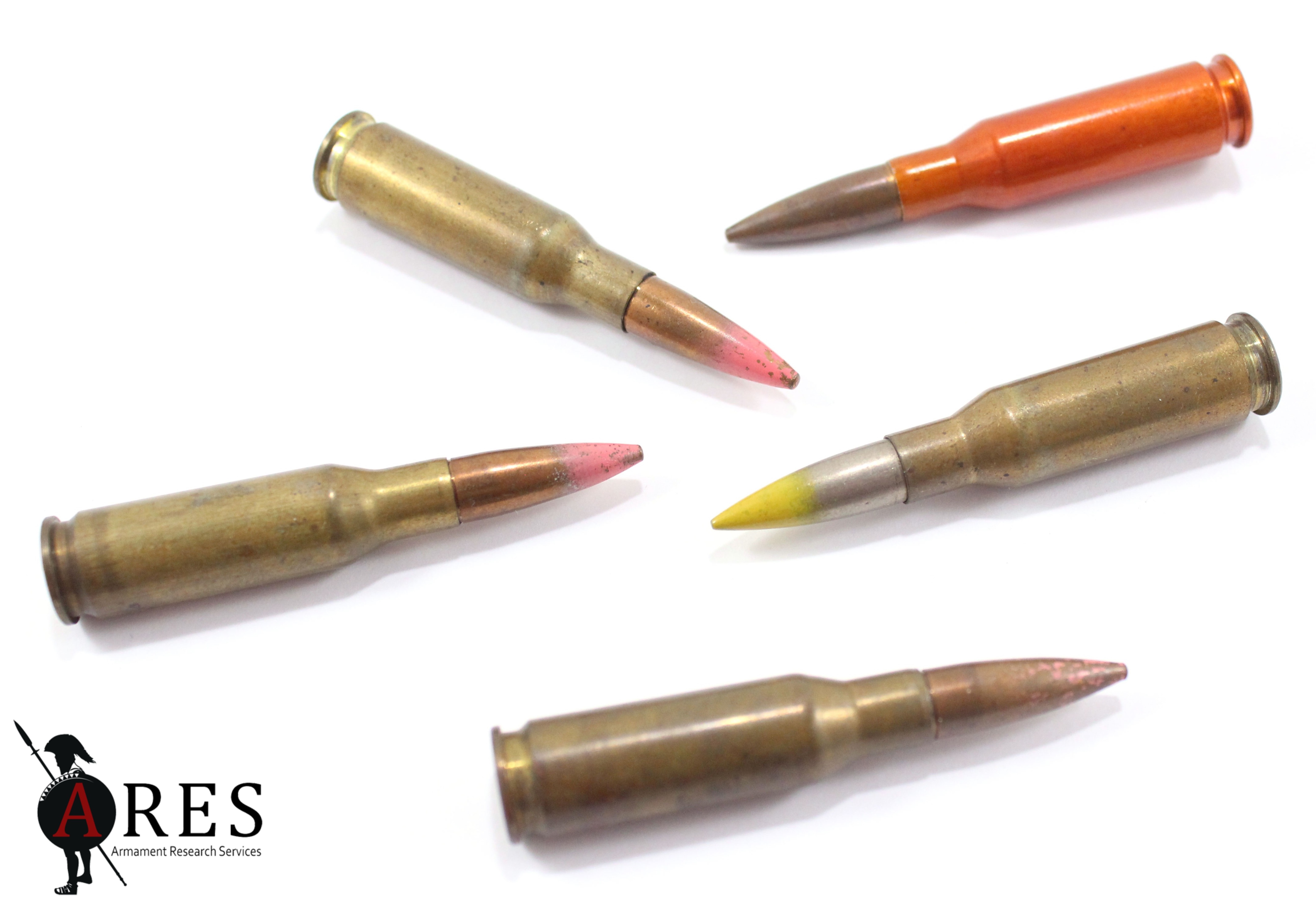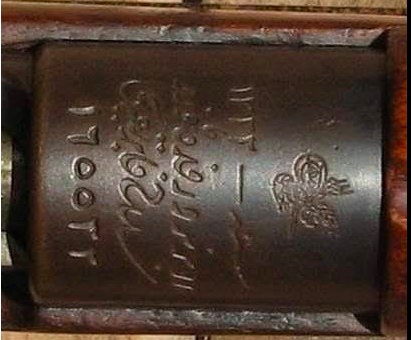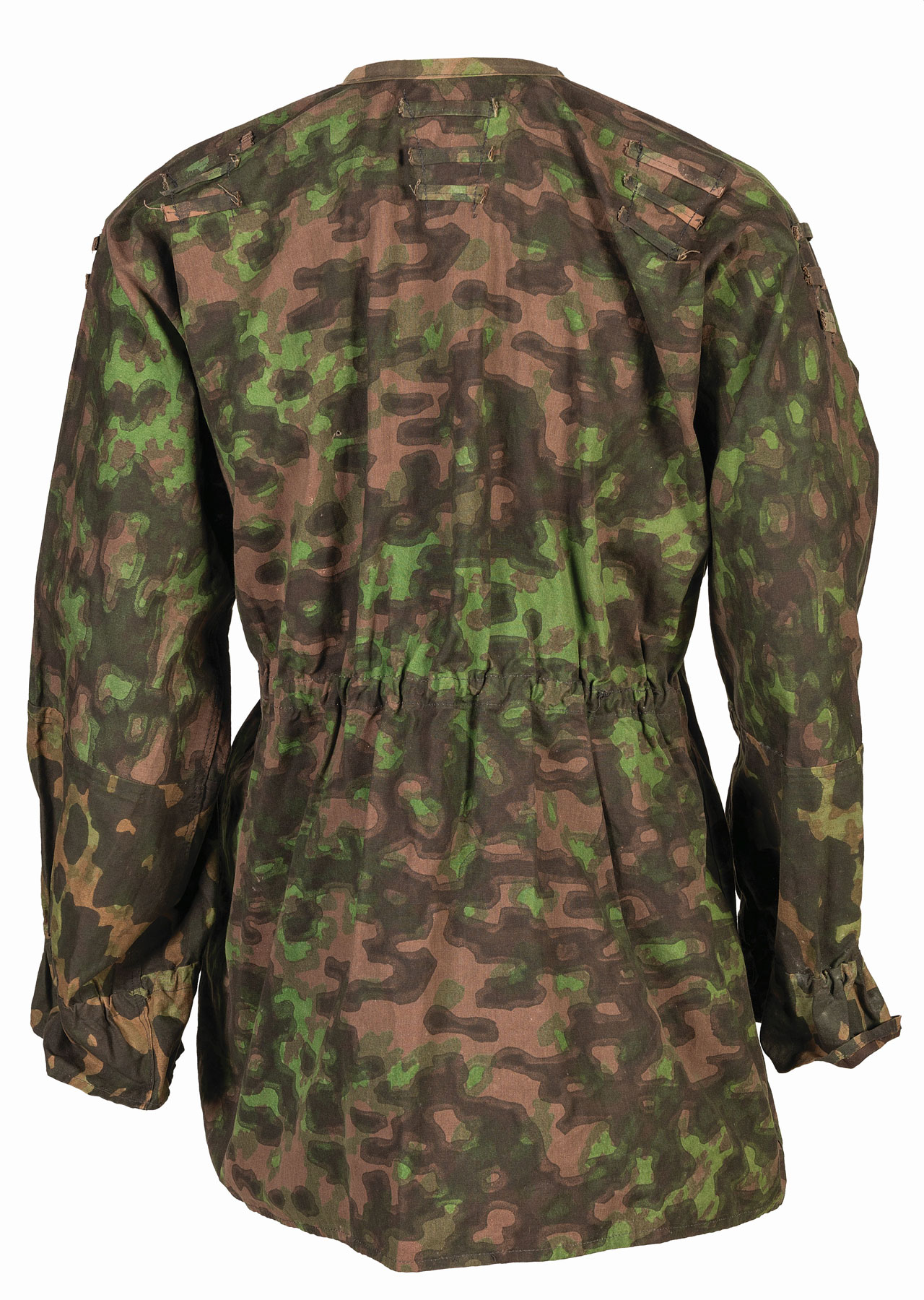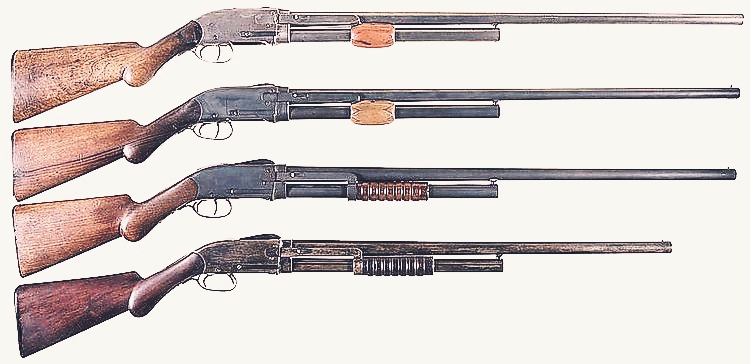By Bert Hartman
The Winchester .22 Caliber Single Shot Musket (Winder Musket) was first introduced to the shooting public in late 1904, and it remained in production until June of 1920. Over the course of time, it was eventually manufactured in three distinctly different variations, which I refer to as the First, Second and Third variations. The distinguishing difference between the Winder Musket and the standard Model 1885 Musket is that all three variants were (with a very rare few exceptions) chambered solely for the .22 caliber rim-fire cartridge versus a center-fire cartridge. There was nearly an even split between the 22 LONG R. and the 22 SHORT cartridges when the totals for all three variants is included.
All three Winder Musket variations were manufactured with a large shank, 28-inch round barrel, that was approximately the same size as a No. 3 round barrel on the standard Sporting Rifle. Unlike the standard Model 1885 rifles that could be ordered with a variety of barrel lengths, shapes, and sizes, the Winder Musket was only available with just one barrel type. Plain (non-set) triggers were standard, although a few examples of the First and Second variation were made with a single-set or a close-coupled set-trigger. A dovetail slot was never milled in the barrel for a rear sight. The frames were always blued, but the hammer, trigger, lever, and breech block were nearly always case color hardened. In the following paragraphs, each variant will be discussed in further detail.
The First Variation: The production period for the First variation Winder Musket was from October of 1904 through December of 1911. The serial number range for the First variation is 96,600 – 112,500, but there are a small number of specimens that have been found on both sides of the expected serial range. Serial number 96701 is listed in the factory ledgers as being received and logged into the factory warehouse on October 24th, 1904, and shipped the same day. As of this writing, I have not found one with an earlier date.
The First variation was built on a high-wall thin-side frame with a flat-spring action up to circa March 1908, and then a coil-spring action could have been used thereafter (though very few are encountered, and those found are usually Take Down actions). It featured a barrel mounted rear sight that was either a Buffington Hotchkiss style, or a Krag-Jorgensen Model 1901 military wind gauge sight. Regardless of which type of sight was used, it was mounted to the barrel several inches forward of the frame ring. The earliest examples were predominantly equipped with the Hotchkiss rear sight, but the majority of them will be found with the Krag-Jorgenson sight.
The top picture below is serial no. 107312, equipped with a Hotchkiss rear sight. The bottom picture is serial no. 106046, equipped with a Krag-Jorgenson Model 1901 rear sight.


The front sight on this variation is a milled steel semi-ramp block that was silver-soldered to the barrel. It has a longitudinal groove milled in it, with a thin steel blade that is pinned in place.
The forend stock was retained to the barrel with a pair of barrel bands and spring clips (identical to the standard Model 1885 Musket), and it was not manufactured with the elongated finger groove found on the later variations. The stock was bored for a steel wiping rod storage.
The vast majority of the First variation Winder Muskets were chambered for the 22 LONG R. cartridge, with a small number of them chambered for the 22 LONG and 22 SHORT cartridges (refer to the chart near the end of this article)
Take Down frames were first offered starting in 1908, but they are rarely found on the First variation Winder Muskets. The vast majority were flat-spring solid frame actions (98.55%), with a very small percentage of coil-spring Take Down actions made (1.45%).
Author Herbert G. House1 indicated that a total of 7,418 First variation Winder Muskets were sold from October 1904 through December 1907, and that sales from January 1908 through December 1911 totaled an additional 1,884 units. Based on my own very careful and thorough research of the original Winchester factory warehouse ledger books, that production and sales number is not possible. Total production of the Model 1885 (all variations) from October 1st, 1904 through December 31st, 1907 was just 9,616 units, with the overwhelming majority of them being Sporting Rifles. If you include the total production through the end of December 1911, the total Model 1885 production was 15,070 units, again with the vast majority of them being Sporting Rifles. For the October 1904 through December 1911 time period, I have thus far verified that just 1,652 First variation Winder Muskets were manufactured and sold. Total production is unlikely to exceed 1,800. There were undoubtedly a few additional First variations made beyond December of 1911 to use up the remaining parts on hand.
The Second Variation: The production period for the Second variation Winder Musket began in December 1911 (per Change in Manufacture Notice 13671), and was concluded in December of the year 1917. There were a small number of additional units made up through 1919 to use up the remaining parts that were on hand. The normal serial number range is from 112,500 to 121,800, and again, there are a small number of specimens that will be found on both sides of the stated serial range. The total production number for the Second variation is estimated to be 4,000 units.

The Second variation Winder Musket was also built on a high-wall thin-side frame, but exclusively with the coil-spring action (as marked with an “A” on the bitter end of the lower tang). It was available in the Take Down frame throughout its entire production period, and a very substantial number of them were manufactured with that feature. Based on the raw numbers derived from my ongoing research survey, approximately 47% of the total Second variation production consisted of Take Down frames (230 of 473 surveyed thus far). If we use the estimated total production number of 4,000, then extrapolate the number of Take Downs using the data I have collected thus far, the total Take Down production would have been approximately 2,130 units. Based on my personal experience and what I have observed in my travels, I believe that the estimated 2,130 production number is very close to the actual number that were manufactured.
The Second variation Winder Musket also featured a barrel mounted Krag-Jorgensen Model 1901 military wind gauge rear sight, but in all cases observed by this author, the sight is mounted to the barrel immediately forward of the frame ring. This was done to reduce the distance between the rear sight and the shooters eye to aid in shooting accuracy. A scant few specimens in the 121100 – 121300 serial number range (early 1918) were factory equipped with the frame mounted Lyman No. 53 receiver sight that is ordinarily found on the Third variation Model 87 low-wall Winder Muskets.
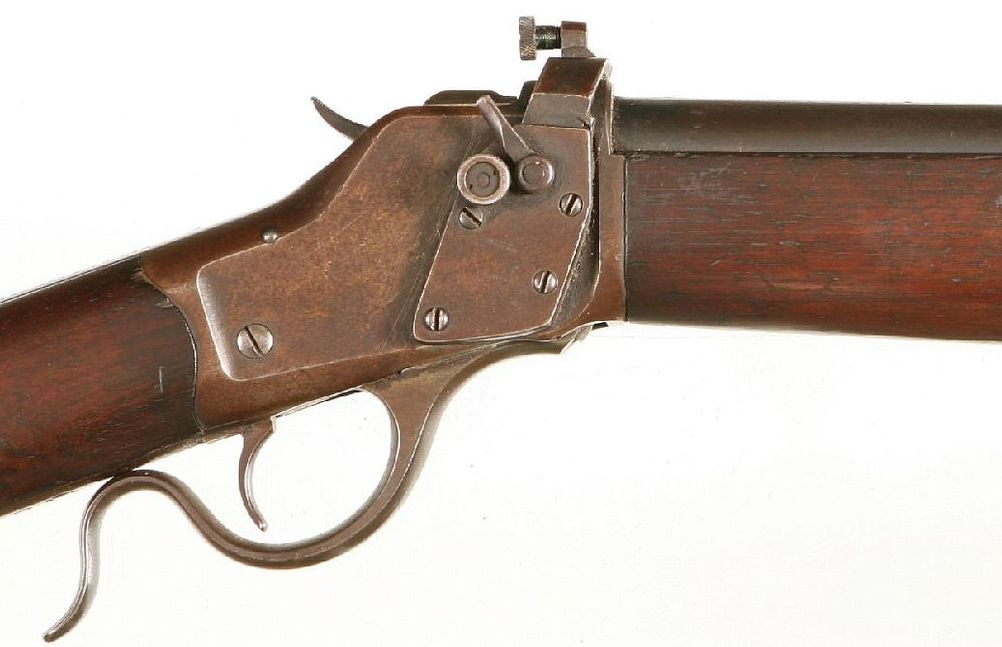 Pictured to the right is serial number 121195 with a factory installed Lyman No. 53 receiver mounted peep sight. Serial numbers 121194 and 121197 were identically made to 121195. These were all parts clean-up units that were manufactured in 1918 after production of the Third variation had begun.
Pictured to the right is serial number 121195 with a factory installed Lyman No. 53 receiver mounted peep sight. Serial numbers 121194 and 121197 were identically made to 121195. These were all parts clean-up units that were manufactured in 1918 after production of the Third variation had begun.
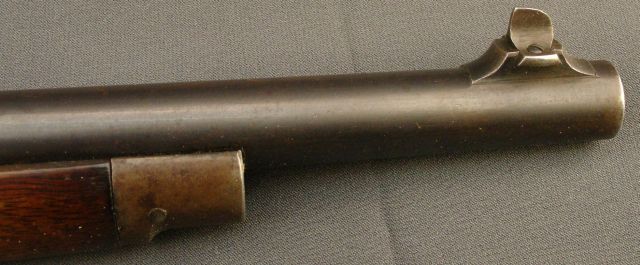 The front sight pictured on the right is a milled steel ramp that is silver-soldered to the barrel. Instead of using a pinned blade, it has a standard 3/8” milled dovetail slot, with a No. 93 style blade front sight.
The front sight pictured on the right is a milled steel ramp that is silver-soldered to the barrel. Instead of using a pinned blade, it has a standard 3/8” milled dovetail slot, with a No. 93 style blade front sight.
The most noticeable difference between the First and the Second variation Winder Musket is the forend stock. The forend stock on the Second variation is retained by a single barrel band and spring clip, and it features an elongated finger grasping groove. It also has a slight perch-belly shape, whereas the First variation is perfectly straight across the bottom. Lastly, the steel wiping rod and the corresponding hole bored in the stock for it were omitted.
The cartridge chambering was split between the 22 LONG R and 22 SHORT, with the 22 LONG R being an overall 3:1 favorite and the predominant cartridge chambering in the first half of the production period. Oddly enough, I have personally encountered two Second variation Winder Muskets that were factory chambered for the 25-20 W.C.F. center-fire cartridge. The first is serial number 117300, and it is additionally a Take Down. The second is serial number 121153, which is a solid frame. Both have a 28-inch round barrel that is identical in all respects to the .22 caliber barrels, and all other observed features were identical except for the center-fire breech block and firing pin. Apparently Winchester was toying with the idea of making a small-bore center-fire variant, but they did not follow through with the concept.
Both the First and Second variation Winder Muskets were listed and cataloged as a “.22 Caliber Single Shot Musket”. According to Herbert Houze1, an unknown number of the early First variation Winder Muskets were shipped to the Ohio National Guard (Col. Charles B. Winder), and to the New York Public Schools Athletic League (Gen. George W. Wingate). Total production of the First and Second variation Winder Muskets is estimated to be 5,800 units (based on my research figures). I am currently researching the original factory ledgers to determine exactly how many of each variation are in the range that can be lettered by the Cody Firearms museum.
The Third Variation:
The production period for the Third variation was from January of 1918, to June of 1920 (when regular production of the Model 1885 Single-shot ceased). The serial number range is 121,800 – 139,700, but early in production, a fair number of guns were made using leftover high-wall frames in the 100,000 –109,000 serial range. There were several hundred additional guns made up through late 1923, when Winchester finally ceased assembling them from remaining parts on hand and sold all of the remaining parts to R.F. Sedgley of Philadelphia, PA

For a reason unknown to this author, the Third variation was cataloged and listed by Winchester as the “Model 87”, but it is a Winchester Single Shot (Model 1885) in all respects. It was built on what would appear to the casual observer to be a low-wall frame, with a coil spring action only, and it was never offered in Take Down.
As I previously alluded to, the receiver frame of the Model 87 externally appears to be a low-wall, but in reality, it is a high-wall frame that was milled down to make it appear and function like a low-wall. Unlike the traditional low-wall frame which was threaded for a small-shank (.845”) diameter barrel, the Model 87 is threaded for a large shank (.935”) diameter (high-wall) barrel. The upper and lower tangs are much thicker than a traditional low-wall, and all parts including the stocks can be readily interchanged with a Second variation Winder Musket. One notable difference is the fact that the Model 87 barrel was never drilled and tapped for a rear sight, whereas the First and Second variation barrels always were. My theory on why Winchester used a high-wall frame versus a traditional low-wall frame is this… First, the U.S. Army voiced their complaints about the perceived difficulty in loading the diminutive 22 Short cartridge in the high-wall action, and therefore requested the frame modification be made. Second, Winchester still had a lot of leftover Winder Musket parts and tooling on hand (from the Second variation production). It was simply much easier (and undoubtedly more cost effective) to mill a high-wall receiver frame down to the desired dimension and continue to use the exact same parts previously manufactured for the Second variation than it would have been to redesign a whole new musket. Very little in the way of new tooling was needed to manufacture the Model 87.
The vast majority of the Model 87s will be found chambered for the 22 SHORT cartridge, but a very small percentage were chambered for the 22 LONG R cartridge (less than 2% of the total production). In April of 1919, Edwin Pugsley was asked to rechamber a small number of them for the 22 LONG R cartridge in anticipation that the government would shortly make that change. Unfortunately, the U.S. Government canceled the remaining contract orders due to the impending Armistice and the subsequent end of WW I, and as a result, Winchester decided not to pursue the rechambering project. Coincidentally, Winchester also discovered that the accuracy of the rechambered Model 87s was poor due to the 1:20 rifling twist rate used for the 22 Short cartridge. The 1:20 rifling twist rate was not capable of adequately stabilizing the heavier 40-grain bullet used in the 22 LR. There were also a very scant few Model 87 Winder Muskets made for civilian sales that were chambered for the 22 LONG rim fire cartridge, and at least one specimen that was factory chambered for the 25-20 W.C.F. repeater cartridge (serial number 121609, which is the third Winder Musket found in this caliber).
The front sight and forend stock on the Model 87 are identical to the Second variation Winder Musket, but shortly after production began, a transverse band screw was used to retain the barrel band versus a spring clip (that change was an Edwin Pugsley innovation to simplify production, and it was authorized May 6th, 19181).
The Model 87 featured a new style Lyman No. 53 receiver peep sight that was mounted on the right-hand side of the frame with four 6-48 screws. This moved the rear sight even closer to the shooter’s eye as well as increasing the sight radius, both of which helped to promote more accurate shooting results.
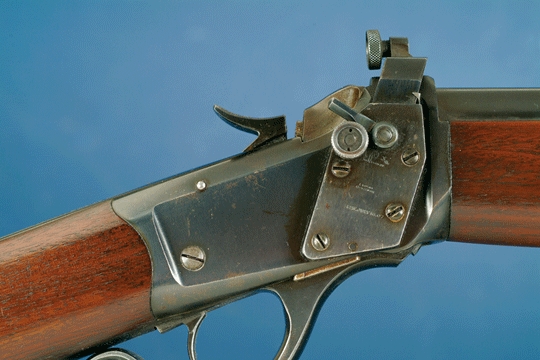
The Third variation Winder Musket is the only confirmed variation that was specifically manufactured for the U.S. Military. Winchester signed a contract with the U.S. Army in late 1917, and the first order (for 2,000) was let on December 5th, 1917. Actual production began in early January of 1918. Of the estimated 12,750 Model 87 Winder Muskets manufactured, 11,419 of them were shipped to the United States Army’s Springfield armory. Those that were accepted by the U.S. Army were stamped on the upper part of the frame directly behind the hammer with the letters “U S” and a flaming ordnance bomb as shown in the picture below.
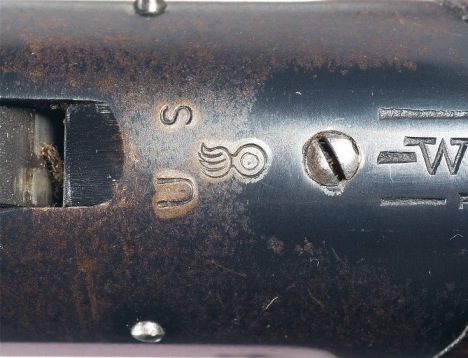
According to my research of the Springfield Research records, many of those martially marked Model 87s ended up in National Guard units, College and High-school ROTC units, Railroads, and U.S. Coast Guard stations. Those same records show they were then later disposed of through the DCM in the years 1922 – 1942.
It is very probable that the manufacture of the Model 87 Winder Musket for the U.S. Army was the direct result of General Pershing’s influence. The following ad was found on the inside front cover of Nov. 10, 1917 issue of Arms And The Man – the NRA origin of American Rifleman magazine.
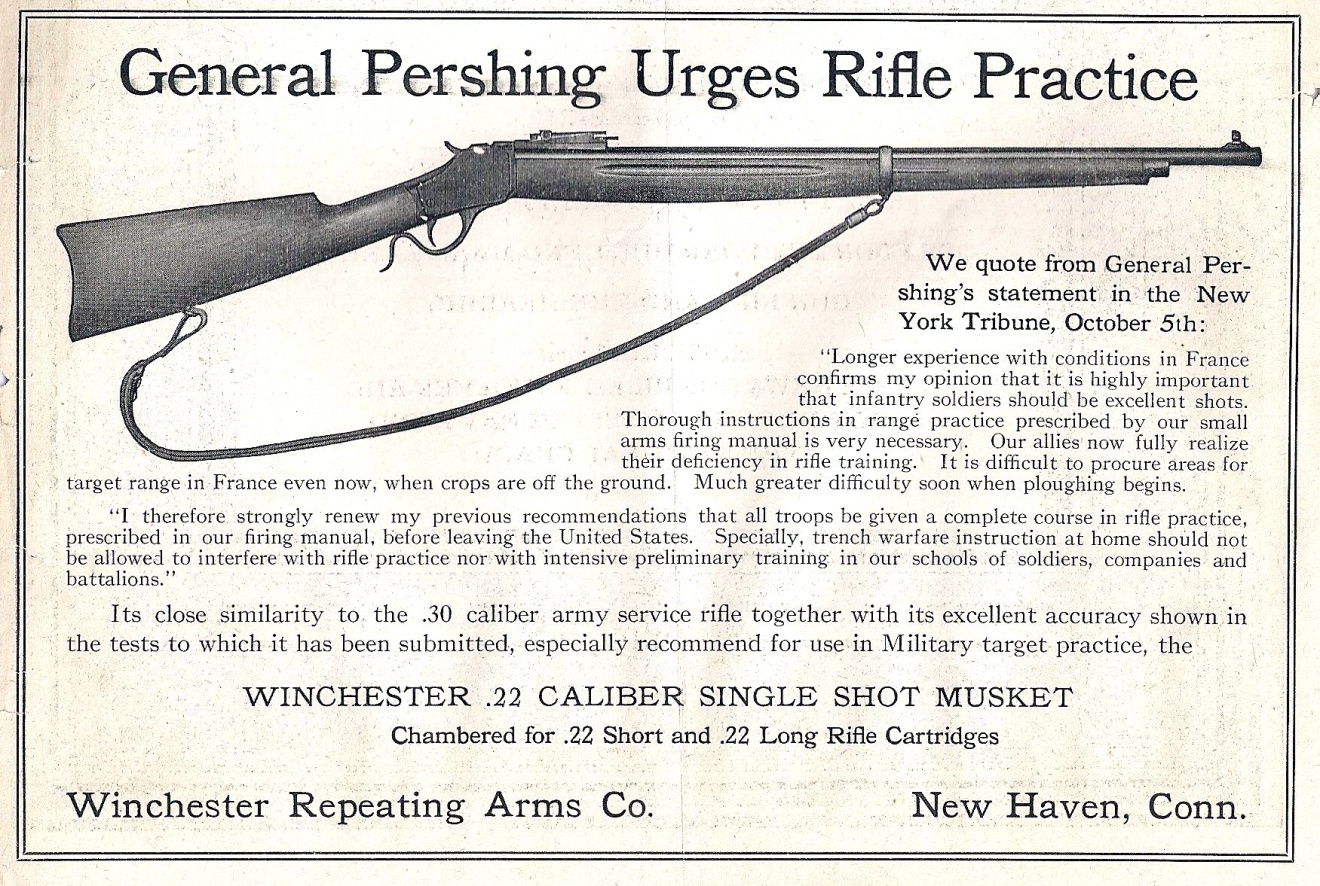
According to records compiled by Herbert G. Houze1, a total of 28,576 Winder Muskets were manufactured and sold. My research indicates that the production total was much closer to 19,000. The following table was presented by Herbert G. Houze in his superbly written reference book, “To The Dreams of Youth, Winchester .22 Caliber Single Shot Rifles”
Model 1885 (Winder Musket) Sales Table:
1904…………… 1,505
1905…………… 1,779
1906…………… 1,907
1907…………… 2,227
1908…………… 581
1909…………… 383
1910…………… 532
1911…………… 388
1912…………… 393
1913…………… 618
1914…………… 727
1915…………… 1,539
1916…………… 1,460
1917…………… 1,802
1918…………… 7,354 (includes 6,692 sold to the U.S. Government*)
1919…………… 5,010 (includes 4,627 sold to the U.S. Government*)
1920…………… No figures available
1921…………… 64
1922…………… 32
1923…………… 275
* U.S. Government sales include:
2,000 per contract 16363 of December 5, 1917
6,289 per contract P3745-1549Sa of May 15, 1918
2,000 per contract P10430-1903Sa of June 21, 1918
1,000 per contract P11979-2051Sa of July 16, 1918
To wrap this up and summarize, the manufacture and production of the three Winder Musket variations was quite significant for Winchester, especially when one considers that it amounted to nearly 14% of the total Model 1885 production. These particular Winchesters are quite often passed over at most gun shows and by collectors in general, but they represent the undeniable Winchester craftsmanship, and they are truly excellent shooters.
The table below is a summarization of all the Winder Muskets I have recorded in my research survey thus far:
Variation |
22 LONG R. |
22 SHORT |
22 LONG |
Total |
Winder Musket (1st var.) |
1,606 |
11 |
67 |
1,684 |
% of Total |
95.37% |
0.65% |
3.98% |
44.75% |
|
|
|
|
|
Winder Musket (2nd var.) |
416 |
136 |
0 |
552 |
% of Total |
75.36% |
24.64% |
0.00% |
14.67% |
|
|
|
|
|
Model 87 |
52 |
246 |
5 |
303 |
% of Total |
17.16% |
81.19% |
1.65% |
8.05% |
|
|
|
|
|
Model 87 (U.S. marked) |
1 |
1,223 |
0 |
1,224 |
% of Total |
0.08% |
99.92% |
0.00% |
32.53% |
|
|
|
|
|
Total |
2,075 |
1,616 |
72 |
3,763 |
% of Total |
55.14% |
42.94% |
1.91% |
Finally, and for all of you interested readers, I am still conducting a statistical survey for all of the surviving Winder Muskets that I can locate in an attempt to recreate the destroyed factory records to the maximum extent possible. As of this writing, I have 3,206 Winder Muskets listed in my survey. If you own a Winder Musket, and are interested in participating in this survey, please see below.
Download/View the Survey Form
Bert Hartman
1 “To The Dreams of Youth, Winchester .22 Caliber Single Shot Rifles” by Herbert G. Houze
